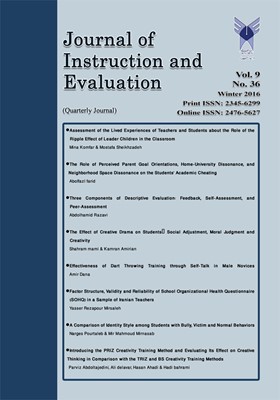مقایسه سبکهای هویت دانشآموزان با رفتارهای قلدری، قربانی و دانشآموزان عادی
الموضوعات : Educational Psychology
نرگس پورطالب
1
![]() ,
میرمحمود میرنسب
2
,
میرمحمود میرنسب
2
1 - دانشجوی دکتری روانشناسی تربیتی، دانشگاه تبریز، ایران
2 - دانشیار گروه علوم تربیتی، دانشگاه تبریز، ایران
الکلمات المفتاحية: سبکهای هویت(اطلاعاتی, هنجاری, اجتنابی/سردرگم), قلدر, قربانی و دانشآموزان,
ملخص المقالة :
هدف پژوهش حاضر مقایسه سبکهای هویت دانشآموزان قلدر، قربانی و عادی بود. طرح پژوهش حاضر از نوع طرحهای علی – مقایسهای میباشد. جامعه آماری پژوهش شامل دانشآموزان پسر دوره متوسطه بود که در سال تحصیلی 94- 93 در شهر تبریز مشغول به تحصیل بودند. نمونه آماری پژوهش را، 372 نفر از دانشآموزان مدارس پسرانه با میانگین سنی 16 سال تشکیل میدادند که به روش نمونهگیری تصادفی چند مرحلهای و از طریق سرند کردن برگزیده شدند. برای انجام این پژوهش نمونه مد نظر از طریق انتخاب معلمان و تکمیل پرسشنامه قلدر- قربانی الویوس انتخاب و به وسیله پرسشنامه سبکهای هویت برزونسکی مورد آزمون قرار گرفتند. برای تحلیل دادههای جمعآوری شده از روش تحلیل واریانس چند متغیره استفاده شد. یافتههای این پژوهش نشان داد که بین سبکهای هویت دانشآموزان قلدر، قربانی و عادی تفاوت معنا دار وجود دارد، به طوری که دانشآموزان قلدر، دارای سبک هویت اجتنابی/ سردرگم و دانشآموزان قربانی دارای سبکهای هویت هنجاری و اطلاعاتی و دانشآموزان عادی دارای سبکهای هویت هنجاری هستند؛ از نظر تعهد هویت بین سه گروه تفاوت معناداری مشاهده نشد. یافتههای پژوهش حاضر تأثیر ویژگیهای قلدری و قربانی را در سبکهای هویت برجسته نمود؛ لذا این یافتهها میتواند، راهگشای تحقیقات بیشتر، در خصوص متغیرهای پژوهش، در آینده باشند


